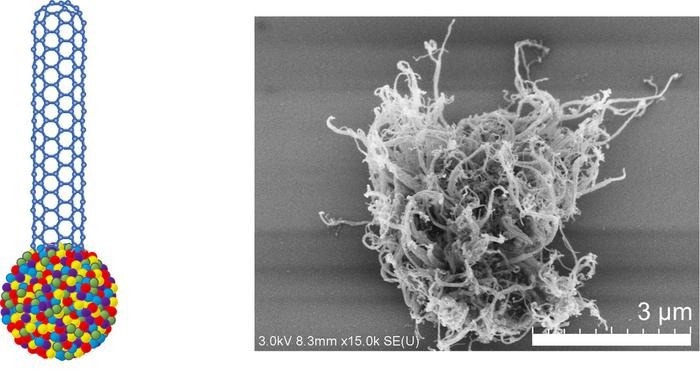Reviewed by Lexie CornerApr 4 2024
The exceptional properties of high entropy alloys (HEAs), including high strength and hardness, as well as high thermal and chemical stabilities, have garnered considerable interest across various industries.
 Model diagram of a single-walled carbon nanotube generated from high entropy alloy nanoparticles (left) and scanning electron microscope image of the nanotube (right). Image Credit: Takahiro Maruyama/Meijo University
Model diagram of a single-walled carbon nanotube generated from high entropy alloy nanoparticles (left) and scanning electron microscope image of the nanotube (right). Image Credit: Takahiro Maruyama/Meijo University
In contrast to conventional alloys, which often contain small amounts of one or two additional metals, HEAs are characterized by a solid solution of five or more metals in equal atomic ratios. This distinctive composition gives rise to intricate surface structures harboring diverse active sites conducive to catalytic reactions. Consequently, due to their catalytic potential, HEA nanoparticles (NPs) have garnered significant attention in recent years.
Despite their potential, HEA NPs have never been employed as catalysts for the growth of single-walled carbon nanotubes (SWCNTs). SWCNTs, or carbon nanotubes on a nanoscale, are valuable in various applications, such as battery components and biosensors for medical and agricultural use. They demonstrate remarkable properties like exceptional strength and thermal and electrical conductivity. Therefore, the development of efficient catalysts is imperative to meet the growing demand for SWCNT synthesis methods.
In a groundbreaking study, a group of Japanese scientists, under the direction of Professor Takahiro Maruyama of Meijo University’s Department of Applied Chemistry, successfully grew SWCNTs for the first time using HEA NPs.
CNTs hold immense potential across numerous domains. If we can reduce their synthesis cost and achieve selective SWCNTs growth through catalyst improvements, it could pave the way for high-speed devices and various optical sensors, making our lives more comfortable.
Takahiro Maruyama, Professor, Department of Applied Chemistry, Meijo University
Maruyama sheds light on the motivation behind their study.
Their findings were made available online on March 6th, 2024. The study will be published in Chemical Physics Letters on April 16th, 2024.
Prof. Maruyama's group has grown SWCNTs before using catalysts made of single metals like iridium, platinum, and rhodium. Using HEA NPs made of five platinum group metals (5 PGM), namely rhodium, rubidium, palladium, iridium, and platinum, they built on their findings in this study.
Considering that PGM HEA NPs often have higher activities than individual PGM catalysts, we theorized that HEA NPs composed of PGMs might act as highly active catalysts for growing SWCNTs.
Takahiro Maruyama, Professor, Department of Applied Chemistry, Meijo University
The group created SWCNTs by growing layers of materials on a solid surface in a vacuum, atom by atom, using the chemical vapor deposition (CVD) method. Using acetylene as the feedstock, CVD was performed for 10 mins at 750 ℃ using 5 PGM HEA NPs as catalysts. High-density SWNCTs with lengths greater than one micrometer grew as a result. A Raman analysis revealed that the diameters of the SWNCTs ranged from 0.83 to 1.1 nm.
They also created SWNCTs using the individual metals as catalysts in the same CVD process as iron and cobalt, the most widely used catalysts for producing high-yield SWCNTs, to compare the performance of the HEA NPs.
The results of the experiments showed that the catalytic activity of HEA NPs was similar to that of iron and cobalt and significantly higher than that of the individual PGM metals. The scientists attributed this high activity to the distinct surface structure of HEA NPs, which offer a variety of active sites for catalytic reactions because of the diversity of their atomic structure.
Our results show that 5 PGM HEA NPs are highly suitable for the growth of small-diameter SWNCTs, representing a completely new matchmaking between materials. Moreover, given the countless combinations possible for HEA composition, our study can pave the way for even superior catalysts.
Takamura, Professor, Meijo University
Overall, the research opens new directions in the study of carbon nanotubes by demonstrating the efficacy of HEA NPs as catalysts for the development of high-quality SWCNTS.
Journal Reference:
Omae, T., et al. (2024) Development of nanostructured Ge/C anodes with a multistacking layer fabricated via Ar high-pressure sputtering for high-capacity Li+-ion batteries. Applied Physics Express. 10.35848/1882-0786/ad2785